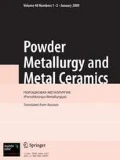The structure and properties of biogenic hydroxyapatite ceramics for medical applications produced by microwave and conventional sintering at 800, 900, 1000, and 1100°C are studied. It is established that microwave sintering allows a 33 to 50% decrease in the minimum grain size, which can be attributed to the influence of microwaves on the material structure compared to conventional sintering. The bioceramic samples produced by microwave sintering have stable porosity (~40%) and 30–59 MPa compressive strength, being close to that of native bone and 1.6 to 2 times higher than the compressive strength of samples prepared by conventional sintering. In vitro studies have shown that the solubility of bioceramics sintered in a microwave oven in saline is 1.7 to 5.5 times higher than the solubility of samples produced by conventional sintering. Thus, microwave sintering allows obtaining biogenic hydroxyapatite ceramics with improved mechanical and biological properties for filling bone defects in orthopedics and traumatology.





Similar content being viewed by others
References
U. Heise, J. F. Osborn, and F. Duwe, “Hydroxyapatite ceramic as a bone substitute,” Intern. Orthop., No. 14, 329–338 (1990).
S. V. Dorozhkin, “Bioceramics of calcium ortophosphates,” Biomaterials, 31, No. 7, 1465–1485 (2010).
V. I. Putlyaev, “Modern bioceramic materials,” Soros. Obrazov. Zh., 8, Issue 1, 44–50 (2004).
A. Raksujarit, K. Pengpat, G. Rujijanagul, et al., “Processing and properties of nanoporous hydroxyapatite ceramics,” Mater. Design, 31, No. 4, 1658–1660 (2010).
Y. Gao, W.-L. Cao, X.-Y. Wang, et al., “Characterization and osteoblast-like cell compatibility of porous scaffolds: bovine hydroxyapatite and novel hydroxyapatite artificial bone,” J. Mater. Sci.: Mater. Med., 17, 815–823 (2006).
A. Nakahira, T. Murakami, T. Onokiand, et al., “Fabrication of porous hydroxyapatite using hydrothermal hot pressing and post-sintering,” J. Am. Ceram. Soc., 88, No. 5, 1334–1336 (2005).
Y. Zhang, K. Zuo, and Y.-P. Zeng, “Effects of gelatin addition on the microstructure of freeze-cast porous hydroxyapatite ceramics,” Ceram. Int., 35, No. 6, 2151–2154 (2009).
S. Dasgupta, S. Tarafder, A. Bandyopadhyay, et al., “Effect of grain size on mechanical, surface and biological properties of microwave sintered hydroxyapatite,” Mater. Sci. Eng. C, 33, No. 5, 2846–2854 (2013).
S. J. Kalita and S. Verma, “Nanocrystalline hydroxyapatite bioceramic using microwave radiation: synthesis and characterization,” Mat. Sci. Eng. C, 30, No. 2, 295–303 (2010).
R. Nazira, N. Iqbala, A. S. Khana, et al., “Rapid synthesis of thermally stable hydroxyapatite,” Ceram. Int., 38, No. 1, 457–462 (2012).
Z. Yanga, Y. Jianga, Y. Wang, et al., “Preparation and thermal stability analysis of hydroxyapatite derived from the precipitation process and microwave irradiation method,” Mater. Lett., 58, No. 27–28, 3686–3590 (2004).
Y. Fang, D. K. Agrawal, D. M. Roy, et al., “Microwave sintering of hydroxyapatite ceramics,” J. Mater. Res., 9, No. 1, 147–151 (1994).
O. Sych and N. Pinchuk, “Effect of type of calcium phosphate on microstructure and properties of glass reinforced biocomposites,” Proc. Appl. Ceram., 1, No. 1–2, 1–4 (2007).
F. N. Oktar, “Microstructure and mechanical properties of sintered enamel hydroxyapatite,” Ceram. Int., 33, 1309–1314 (2007).
G. Gergely, F. We’ber, I. Luka’cs, et al., “Preparation and characterization of hydroxyapatite from eggshell,” Ceram. Int., 36, No. 2, 803–806 (2010).
D. S. Seo and J. K. Lee, “Dissolution of human teeth-derived hydroxyapatite,” Ann. Biomed. Eng., 36, No. 1, 132–140 (2008).
A. S. Ivashutenko, Corundum–Zirconium Nanoceramics Produced Using High-Intensity Energy Flows [in Russian], Author’s Abstract of PhD Thesis, Tomsk (2010), p. 22.
A. S. Vanetsov, Microwave Sintering of Oxide Powders [in Russian], available at http://www.chem.msu.su/rus/teaching/kaul/8Microwave_red.pdf.
G. A. Libenson, V. Yu. Lopatin, and G. V. Komarnitskii, Powder Metallurgy Processes. Forming and Sintering [in Russian], Mosk. Inst. Stali Splavov, Moscow (2002), Vol. 2, p. 320.
S. A. Goldstein, “The mechanical properties of trabecular bone: dependence on anatomic location and function,” J. Biomechanics, 20, No. 11–12, 1055–1061 (1987).
Author information
Authors and Affiliations
Corresponding author
Additional information
Translated from Poroshkovaya Metallurgiya, Vol. 53, Nos. 9–10 (499), pp. 92–102, 2014.
Rights and permissions
About this article
Cite this article
Tovstonog, G.B., Sych, O.E. & Skorokhod, V.V. The Structure and Properties of Biogenic Hydroxyapatite Ceramics: Microwave and Conventional Sintering. Powder Metall Met Ceram 53, 566–573 (2015). https://doi.org/10.1007/s11106-015-9651-5
Received:
Published:
Issue Date:
DOI: https://doi.org/10.1007/s11106-015-9651-5




